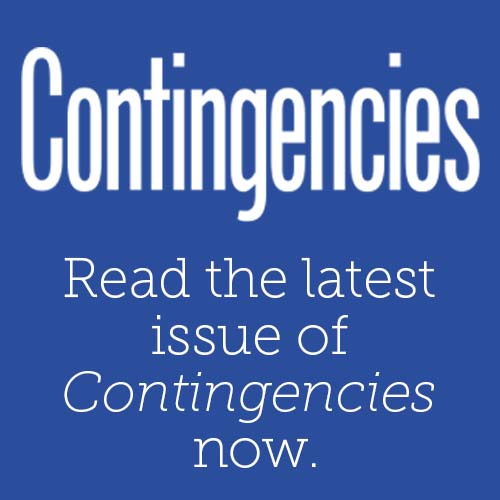The Actuarial Standards Board recently adopted a revision of Actuarial Standard of Practice (ASOP) No. 20, Discounting of Property/Casualty Claim Estimates, which takes effect Dec. 1, 2023. Robert Walling, chairperson of the task force that revised the standard, offered insight on the changes and how they may affect actuaries’ work.
With four actuarial standards of practice open for comment and another expected later this summer, now is a good time for a reminder that your participation in the standards-setting process is invaluable to the Actuarial Standards Board and to the profession as a whole.
The recent emergence of generative artificial intelligence (AI) tools like OpenAI’s ChatGPT has stimulated considerable discussion about how these technologies can be used by actuaries when providing professional services. But actuaries must be sure to take into consideration things like actuarial standards of practice and the Code of Professional Conduct, writes Academy Senior Director of Professionalism Brian Jackson.
Having just earned a newly minted credential, actuaries may feel they are up to date, but continuing education requirements apply as soon as they join one of the five U.S.-based actuarial organizations.
The actuarial profession is rare in that it has, for the most part, successfully remained self-regulated. Decades ago, actuaries established standards for conduct, qualifications, and practice, as well as a means for enforcing them. Professional judgment must be exercised with skill and care to maintain the trust of the public, of principals, and of government entities.
The Actuarial Standards Board and the Actuarial Board for Counseling and Discipline released their annual reports, which offer highlights of 2022 activities of the two entities housed within the Academy.
The Actuarial Standards Board released its 2022 Annual Report, which highlights the board’s accomplishments throughout the year. In 2022, the ASB adopted two revised ASOPs, approved seven exposure drafts for comment, and approved proposals to revise three existing ASOPs.
The actuarial profession is self-regulated—it has created its own standards of conduct, qualifications, and practice, and enforces them through its own disciplinary process. But in the day-to-day practice of professionalism, much is left to you, the actuary, to be a beacon for the profession and everything it stands for in service to our many stakeholders.
The Actuarial Board for Counseling and Discipline (ABCD) released its annual report, highlighting the important activities throughout 2022 of this entity housed within the Academy. The Annual Report 2022 notes that last year the ABCD handled 118 cases—96 requests for guidance and 12 inquiries.
Two actuaries involved in the Committee on Professional Responsibility’s latest discussion paper, Professionalism Considerations for Working in Developing Areas of Actuarial Practice, offer insight in a deep-dive Q&A on the paper.
The Committee on Professional Responsibility (COPR) released a new paper, Professionalism Considerations for Working in Developing Areas of Actuarial Practice, as part of its ongoing discussion series. The paper is intended to raise awareness of the requirements of the U.S. Qualification Standards with respect to work in emerging areas and to help actuaries determine whether they are qualified to practice in a developing area.
The Committee on Professional Responsibility (COPR) released an updated discussion paper, The Roles of the Actuary in the Selection & Application of Actuarial Models, which updates a 2006 paper. Two of the actuaries involved in the update—Karin Swenson-Moore and Brian Donovan—did a Q&A on the updated paper.
The Committee on Professional Responsibility (COPR) has released an updated discussion paper, The Roles of the Actuary in the Selection & Application of Actuarial Models. In preparing this discussion paper, the COPR recognized that there is likely a wide range of experience and opinion within the profession concerning the nature of actuarial models and the various roles actuaries play in selecting and applying them. The COPR believes that actuaries working in all types and areas of professional practice can benefit from reading and considering the concepts and suggestions contained in the paper.
Members are encouraged to share their comments on the paper with the COPR to facilitate improvements in any future releases on this topic. Comments can be submitted to professionalism@actuary.org.
Precept 11 of the Code of Professional Conduct states that “An Actuary shall not engage in any advertising or business solicitation activities with respect to Actuarial Services that the Actuary knows or should know are false or misleading.” What does that mean for your organization’s marketing efforts? Read on to find out more.
The hallmarks of a profession include high levels of expertise gained through years of study and experience, a high level of trust, and upholding high standards of conduct, qualification, and practice. A disciplinary process is also necessary to ensure that those standards are being met, in the public interest.
It’s time once again to make sure you are on track to complete your continuing education (CE) requirements by the end of the year. Because 2023 is the first year for which actuaries must meet the recently revised Qualification Standards for Actuaries Issuing Statements of Actuarial Opinion in the United States (USQS), it’s worth taking a closer look at the requirements.
The Academy has received questions about where members can obtain continuing education (CE) on bias. As a reminder, the revised U.S. Qualification Standards released last fall requires 1 hour of continuing education (CE) each year on bias topics. Here are some places to find it.
It may have been a while since you last looked at Actuarial Standard of Practice (ASOP) No. 1, Introductory Standard of Practice, but ASOP No. 1 is a tool to help you understand all the other ASOPs—a kind of guide or roadmap. Unlike any other standard of practice, it defines terms that are used across the ASOPs
Last year, the Committee on Qualifications (COQ) released completed revisions of the U.S. Qualification Standards (USQS). Since then, the COQ has updated the Frequently Asked Questions (FAQs) on the USQS twice—once in February and once in May. The May release added five new questions to the FAQs, many of which are based on questions and comments received on the draft USQS.
The May “Professionalism Counts” column, “In ‘Interesting Times,’ the Code Is Essential,” explores the importance of the Code of Professional Conduct.






